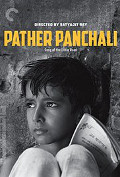
India 1955
Directed by
Satyajit Ray
115 minutes
Rated PG
Reviewed by
Bernard Hemingway


Pather Panchali
Satyajit Ray's first film, a study of life in a remote Bengali village seen through the experiences of one family over a five year period is a remarkable achievement. A one-time painting student, Ray made the film with virtually no money over the course of three years, the Bengali government finally kicking in enough to complete it.Ray was influenced by the work of pioneer film documentarian, Robert Flaherty, and the Italian neo-realist school and his film is as much a documentary as a work of fiction. Capturing the comedy, tragedy and uniqueness of life, it is justly regarded as a classic of humanistic film-making.
My only reservation and this may be personal, is that the film is so beautifully shot (Ray's cameraman had had some experience with still photography) and the performances (all by non-professionals with the exception of the wonderful Auntie, played by Chunibala Devi) so reserved, that the grinding poverty that is its overarching theme is perhaps more intellectually-perceived than felt emotionally. .
Surprisingly, when shown at Cannes the critics panned it, Truffaut apparently walking out mid-way. It is slow and relatively long but it deserves its place in the cinematic pantheon. It was followed by two other films, Aparajito (1956) and The World of Apu (1959) the three collectively known as The Apu Trilogy, although those two subsequent films whilst certainly being commendable do not have the impact of this, Ray's masterpiece.
Want something different?





